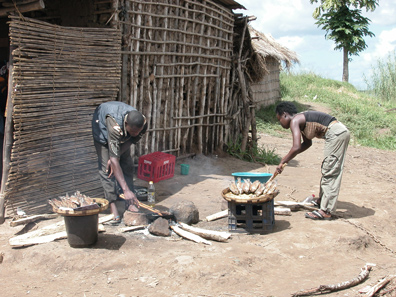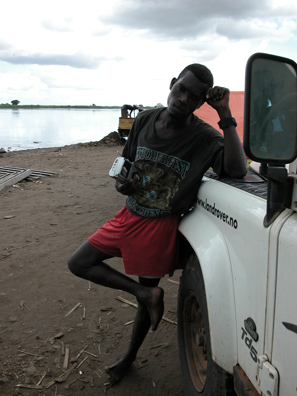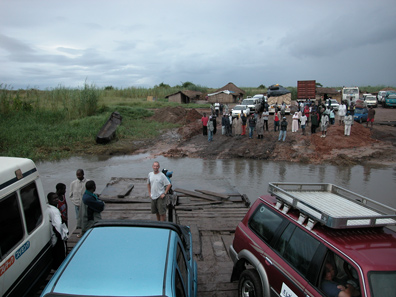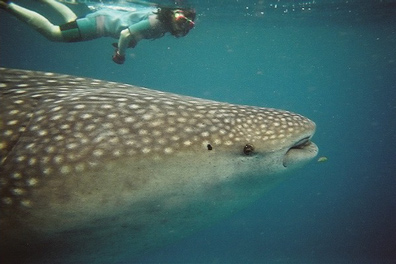| EricD |
| (.416 member) |
| 16/06/05 07:45 PM |
|
|
|
|
The Zambezi river which devides north and south Mozambique. this is from the Caia crossing.

There shouldn't actually be a ferry crossing across the Zambezi river at Caia. The strech of water here is only about 400 meters in the dry season and the beginnings of a bridge are in place on both sides. The funding from europe was also in place to begin with, but as is all too common in africa, much of the money went missing and thus the funding naturally stopped. They are planning for a new bridge, again with europian funding, and hopefully the money will go to building instead of peoples pockets this time because the bridge is dearly needed. It is the only connection between the south and north besides the bridge in the so called Tete corridor which takes you into southern Malawi. This is a long detour for trucks going north/south and for many it's better to wait for the ferry. Waiting is exactly what they are forced to do. As the ferry only can take one big truck at a time and usually doesn't cross more than a few times per day, many trucks have to wait in line 7-9 days! The truck drivers naturally get impatient after a while, so knife fights are appearently very common!
Our hopes for a quick crossing were crushed at once when we talked to several locals and ex-pats waiting there. It seems that the delays of building a bridge are also rooted in local politics. The government (Frelimo) in the south has made sure that infra-structure in the north (predominantly Renamo supporters) has been kept to a minimum... It looks like almost all the political tacticians in african countries went to the same school, as this seems to be the standard way of doing things. One good thing that is happening though, is the road construction in both the north and south. In a years time, the main road through Mozambique will be finished and is looking to be of a high standard, which will cut down travel time with several days!


The main cause of ferry delay was that the riverbank where the pontoon ferry beaches itself, was muddy sand. Every single time it loaded or off-loaded trucks, they got stuck and had to be pulled out with a bulldozer or tractor. Then the riverbank had to be partially reconstructed with new sand/mud. Every time! One man we talked to a for most of the day told us he once had to wait for 3 days evn with a small car because the ferry broke down. Another told us of being on the ferry for 2 days as it was beached on an island farther down the river. Both engines had broken down and they just drifted down there and had to wait until they could be towed upriver again! For people without cars it was a lot easier; small dugout canoes went back and forth all day with passengers and small amounts of goods.
The hours went slowly while we stood around in the sun, occationaly buying a soda from one of the small food stalls. Eventually, A.C. really had to pee, but as there were people everywhere and no obvious place to go squat down, she asked if I could walk with her behind some shacks. Behind the shacks we were immediatly approached by children wanting to sell us a live goat, and then by a leper, babbling incoherently, and making wild justures towards us! We found it wise to retreat! She then went and asked in one of the food stalls if they had a place and was pointed out to the back where there was a large hole covered with a few wooden planks. The planks were loose and at one stage, she almost fell down into the hole, recovering her balance just in time. Since the hole was filled with a thick, vile, excrement soup, it would not have been a worthwhile experiance!

Chaos took on a new meaning when looking at the lack of system to get on the ferry. There is no que system and if you can squeeze past someone elses truck then that's their problem. No wonder there are lots of fights going on here! Words and pictures can't begin to describe the tension and anger amongst the truckdrivers who have waited a week at Caia. Towards the end of the day, the ferry had made 2 crossings and we were finally in front of the small car line. It goes much quicker for small cars as the ferry can only take one big truck in the middle, but several cars on each side. It looked like it would be our turn, when a medium sized truck, backing onto the ferry, got stuck in the mud. He came over to me and requested that we use our winch to get him out. His truck was bigger than I'd prefer to use our winch on and I walked over to the truck with him to have a look. It looked like if all the people standing around pushed from behind, he'd be out quickly. When I told him so, he looked at me discouraged face and said that no one there would lift a finger without being paid. I said that that was silly, since they wouldn't get on the ferry until his truck was loose, thus it would be in their own best interest. He answered that it unfortunatly didn't work that way with his fellow africans, they preferred to wait and watch others sort out the problem. I eventually tried to get some of the people standing around to help, even by accusing them of being weak women (which had worked in Sudan!) but they couldn't bother. In the end the tractor drivers arrived back from wherever they had been and pulled the truck out, dumped more sand in the muddy part and the truck got onto the ferry. What could have taken 3 minutes took an hour.

Since we were in front of the line, we luckily got onto the ferry this time, just as the sunset. Several portugees that have lived in Mozambique all their lives advized us to drive on from the other side in the dark instead of sleeping with all the trucks on the southside. They said it could be quite unsafe at night, but we preferred to stay there, as the alternative was to drive of into the unknown. Well, we didn't get that far. As the ferry swung back and forth to slide of the riverbank, one engine broke down and we drifted off into the river!
It has 2 engines, but just one wasn't stong enough to beach us onto the other side. It barely had enough power to reach the other side because of the strong current! After trying for an hour in the dark, they finally gave up and decided to tie the ferry to the shore with a few ropes. A gangplank was put across the 2 meters seperating us from land, so we could at least go ashore and get something to drink, which we did together with a Danish man living and working in Mozambique. He was the one that had once slept downriver on an island when both ferry engines broke down! Later on we returned to the gangplank and found that it had slipped off the ferry. I slid down to the riverbank, ankle-deep in mud and was able to get the planks back in place. 5 people suddenly stood up around us and thanked me for fixing the gangplank. They had been waiting there for a long time but hadn't bothered to do it themselves. A mentality I find hard to swallow. We put up the roof-top-tent and settled down for the night, but eventually A.C. had to pee again. This wasn't that easy stuck on the ferry, as there were people sitting and sleeping on almost every square meter on the deck. We decided that the best solution was to fetch a small plastic bucket we had in one of the roof top cases so she could pee in the tent. a great idea, exept that we didn't see the small crack in the bottom of the bucket in the dark... This was the one time plastic bedsheets would have been a nice thing to have... Well, there was no use in crying over spilt milk (or pee, as the case was), but we did feel a certain longing for being back home at the moment.
The mechanic began working on the engine early in the morning and by 0900, we finally got our car onto shore. The next thing was to be able to drive around all the trucks and cars in the way so we could get out. I saw an open stretch without cars and backed out towards it wondering why nobody was in the space. People around started saying "no, no it's too muddy there". Others replied that "It's no problem, it's a Land Rover, not a Landcruiser". There seems to be also here, as in Tanzania and Malawi, a general consent that Land Rovers are better in the mud than Toyota Landcruisers. I proved of course to all, that it naturally wasn't a problem for a Land Rover and drove through without a struggle!

So ended our 24 hour, 400 meter long Zambezi adventure and the end result was a bladder infection for A.C., probably from not being able to pee when needed during the last day! We hoped for the truckdrivers that the bridge will be built sooner than later as we continued towards the south, where we could spend some time diving in the Indian Ocean!
When we reached the southern part of Mozambique, we ended up spending over 3 weeks snorkeling and scuba diving near Inhambane. This gave us daily encounters with whalesharks, huge mantarays, dolphins and other marine creatures. The beach is clean, white and "endless" in that area, people friendly and the beer cold! It was a good place to recuperate from intestinal worms and other illnesses that had left us a bit tired. Alas, all was not well as we shortly later found out we had typhoid... But that's another story.
A small 6 meter long whaleshark. The biggest were about 12 meters long! Due to their size, it is a good idea to stay away from their tail, as the power they have is incredable. Getting swatted by a whaleshark tail is not a good idea! Their skin felt kind of rubbery, and one interesting fact is that their eyes can swivel opposite directions at the same time, giving them almost 360 degrees of vision.
